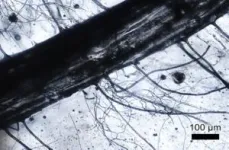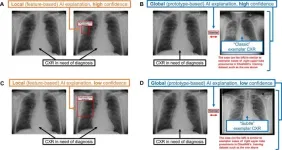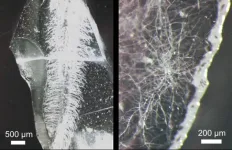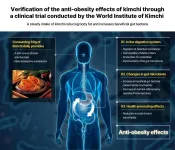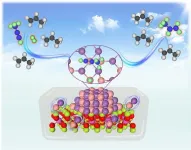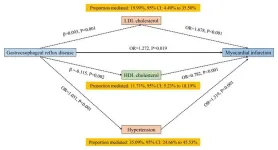(Press-News.org) OAK BROOK, Ill. – Using data collected over a 10-year period from four emergency departments, researchers at the University of Toronto found that short-term exposure to ambient heat and air pollution levels was associated with increased utilization of X-rays and computed tomography (CT). Results of the study were published today in Radiology, a journal of the Radiological Society of North America (RSNA).
“Extreme climate exposures are associated with higher demand for health care including emergency department visits,” said Kate Hanneman, M.D., M.P.H., vice chair and associate professor at the University of Toronto, Department of Medical Imaging, and deputy lead of sustainability at the Joint Department of Medical Imaging at Toronto General Hospital. “However, the impact of climate-related environmental exposure on medical imaging utilization is currently unknown.”
In the retrospective study, the research team analyzed the association between daily imaging utilization counts at four emergency departments in academic hospitals in Toronto, Canada, and local daily ambient environmental data between 2013 and 2022. A time-stratified, case-crossover design was used to control for seasonality, time trends, influence by day of the week, and covariates including age, sex, race and behavioral risk factors.
For the purposes of the study, high heat was defined as a mean ambient temperature greater than 68 degrees Fahrenheit. A high level of air pollution was defined as the presence of fine particulate matter (PM2.5) at levels greater than 12 μg/m3.
Over the study period, 1,666,420 medical imaging exams were performed in the four emergency departments with a mean of 428 exams daily. The mean for daily emergency department visits was 659. The average mean daily ambient temperature was 48.2 degrees (range, -7°F to 85°F), and the mean daily ambient particulate matter was 7.9 μg/m3.
The researchers found that short-term (fewer than seven days) exposures to higher ambient (outdoor) heat and higher PM2.5 air pollution were associated with overall increases in imaging utilization (5.1% and 4.0%, respectively). High heat exposure days and high air pollution exposure days were associated with excess absolute risk of 5.5 and 6.4 imaging studies per 1 million people at risk per day, respectively.
“While the individual daily effects we observed are modest, the cumulative increase in total imaging volumes is substantial,” Dr. Hanneman said.
Over the study period, there were 602 high-heat exposure days and 552 unhealthy high air pollution days. High heat exposure increased by 0.6% (2.2 days) per year while high PM2.5 days decreased by 0.4% (1.3 days) per year over the study period.
“This is consistent with overall improved air quality in Canada and the U.S. over the last two decades attributed to policies aimed at regulating air pollution and the phasing out of coal plants in Ontario,” Dr. Hanneman said. “Despite the decrease in high air pollution days, PM2.5 remains a health threat.”
Heat and air pollution were associated with increased utilization of X-rays and CT, but not ultrasound or MR. High temperatures had a greater effect on X-ray utilization, while high PM2.5 levels were associated with higher CT utilization. Both environmental exposures were associated with increased utilization of chest, neuro and musculoskeletal imaging.
Increased imaging utilization associated with ambient heat was a function of higher emergency department visits, whereas increased utilization related to high PM2.5 levels was a function of both increased patient volumes and increased per-patient imaging.
Dr. Hanneman said data from the study may help radiology departments prepare for and build resiliency to the current and future impacts of climate change.
“As global temperatures continue to rise, the frequency and severity of heat waves and extreme weather events are expected to increase,” she said. “Knowing the impact on our departments will allow us to plan proactively.”
The research was supported by an RSNA Research & Education Foundation Emerging Issues Grant.
###
“Increased Emergency Department Medical Imaging: Association with Short-Term Exposures to Ambient Heat and Particulate Air Pollution.” Collaborating with Dr. Hanneman were Omar Taboun, B.Sc., M.Sc., Anish Kirpalani, M.D., Birgit Ertl-Wagner, M.D., Ph.D., Julien Aguet, M.D., Scott Delaney, Sc.D., J.D., M.P.H., Rachel C. Nethery, Ph.D., Joseph Choi, M.D., M.P.H., Hayley Panet, M.H.Sc., C.H.E., M.R.T. (MR), Maura J. Brown, M.D., Heidi Schmidt, M.D., Ania Kielar, M.D., and Michael Patlas, M.D.
Radiology is edited by Linda Moy, M.D., New York University, New York, N.Y., and owned and published by the Radiological Society of North America, Inc. (https://pubs.rsna.org/journal/radiology)
RSNA is an association of radiologists, radiation oncologists, medical physicists and related scientists promoting excellence in patient care and health care delivery through education, research and technologic innovation. The Society is based in Oak Brook, Illinois. (RSNA.org)
For patient-friendly information on emergency imaging, visit RadiologyInfo.org.
END
OAK BROOK, Ill. – When making diagnostic decisions, radiologists and other physicians may rely too much on artificial intelligence (AI) when it points out a specific area of interest in an X-ray, according to a study published today in Radiology, a journal of the Radiological Society of North America (RSNA).
“As of 2022, 190 radiology AI software programs were approved by the U.S. Food and Drug Administration,” said one of the study’s senior authors, Paul H. Yi, M.D., director of intelligent imaging informatics and associate member in ...
Fukuoka, Japan— Microfluidic technology has become increasingly important in many scientific fields such as regenerative medicine, microelectronics, and environmental science. However, conventional microfabrication techniques face limitations in scale and in the construction of complex networks. These hurdles are compounded when it comes to building more intricate 3D microfluidic networks.
Now, researchers from Kyushu University have developed a new and convenient technique for building such complex 3D microfluidic networks. Their tool? Plants and fungi. The team developed a ‘soil’ medium using nanoparticles of glass (silica) and a cellulose ...
A different mix of fuels with enhanced properties could overcome some of the major barriers to making fusion a more practical energy source, according to a new study.
The proposed approach would still use deuterium and tritium, which are generally accepted as the most promising pair of fuels for fusion energy production. However, the quantum properties of the fuel would be adjusted for peak efficiency using an existing process known as spin polarization. In addition to spin polarizing half the fuels, the percentage of deuterium would be increased from the usual amount of roughly 60% or more.
Models created by scientists at the U.S. Department ...
The American Pediatric Society (APS) is pleased to announce Beth A. Tarini, MD, MS, MBA, as the 2025 Norman J. Siegel New Member Outstanding Science Award recipient for her considerable contributions to pediatric science. The award will be presented to Dr. Tarini during the APS Presidential Plenary at the Pediatric Academic Societies 2025 Meeting in Honolulu, Hawaii, April 24 – April 28.
The award was created in honor of one of the world’s leading nephrologists, Norman J. Siegel, MD, FASN. Dr. Siegel was an outstanding ...
Approximately 16% of the global population, or about 890 million people, suffer from obesity. The World Health Organization (WHO) has recognized obesity as a significant health issue and highlighted its impact on the quality of life and overall health of individuals across the world. In response to this, the World Institute of Kimchi, South Korea, has been publishing a series of articles on the anti-obesity effects of kimchi in international journals. These articles, based on research studies on the subject, indicate that the regular consumption of kimchi, a traditional ...
Researchers delved deep into the regulation of cobalt active sites to enhance the selectivity of propylene to improve scalability and affordability of the production of this important chemical.
Chemical reactions are not always naturally optimized to yield the products in the quantities needed, especially on the scale needed for the amount of industry in the world today. Researchers from East China University of Science and Technology explored the options available to develop a more cost-effective, scalable and straightforward ...
A recent study published in the Journal of Translational Internal Medicine (https://doi.org/10.1515/jtim-2024-0017) reveals significant insights into the broader impact of gastroesophageal reflux disease (GERD) on cardiovascular health. By using a rigorous bidirectional Mendelian randomization (MR) approach, the research provides compelling evidence that GERD—a condition traditionally recognized as a digestive disorder characterized by acid reflux and heartburn—may influence key cardiovascular risk factors, including blood pressure, lipid ...
Repeated exposure to lies online may influence the beliefs of professional content moderators, with consequences for online platforms. Hundreds of thousands of content moderators, typically based in non-Western countries, identify and weed out problematic and false content on social platforms. However, constant exposure to misinformation could convince some content moderators that false claims are true, in what is known as the “illusory truth effect.” Hause Lin and colleagues assessed the extent of this effect among professional content moderators in India and the Philippines and explored whether encouraging an accuracy mindset reduces the effect. ...
COLUMBUS, Ohio – While comics have become a culturally popular and widely studied art form in recent decades, one format remains overlooked: the single-panel comic.
Comics like “The Family Circus,” “Ziggy” and “Little Lulu” are often seen as simplistic and not worthy of critical attention, argues Michelle Ann Abate, author of the new book Singular Sensations: A Cultural History of One-Panel Comics in the United States.
“There tends to be a belief there ...
PULLMAN, Wash. — Unlike kids in the United States, hunter-gatherer children in the Congo Basin have often learned how to hunt, identify edible plants and care for babies by the tender age of six or seven.
This rapid learning is facilitated by a unique social environment where cultural knowledge is passed down not just from parents but from the broader community, according to a new Washington State University-led study in the Proceedings of the National Academy of Sciences.
The research helps explain how many cultural traits have been preserved for thousands of years among ...

